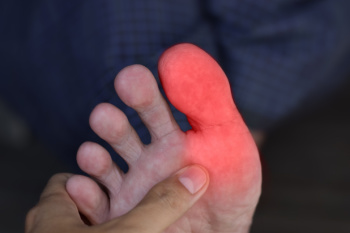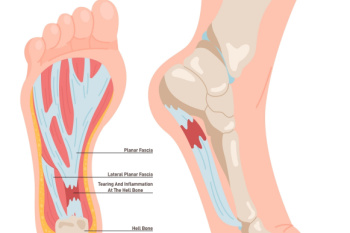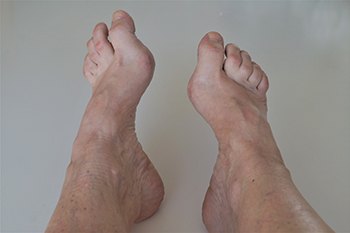February 2024
Pain in the Big Toe Joint

Pain in the big toe joint is a common source of discomfort that affects mobility and overall quality of life for many individuals. Whether stemming from age-related wear and tear, conditions like bunions, or physical injuries, understanding the underlying causes is vital for effective management. Hallux rigidus, characterized by joint degeneration and restricted movement, often accompanies osteoarthritis and may require surgical intervention in severe cases. Bunions are bony protrusions that often necessitate changes in footwear and orthotic support, with surgery as a potential solution for more severe cases. Physical injuries to the big toe joint can lead to swelling, pain, and an increased risk of developing arthritis or other joint-related issues. When conservative treatments fail to provide adequate relief, surgical options such as bunionectomy, joint realignment, or fusion may be needed. If you have persistent pain in the big toe, it is suggested that you make an appointment with a podiatrist for an exam and a diagnosis, before deciding on the right treatment.
Toe pain can disrupt your daily activities. If you have any concerns, contact Dawn Miles, DPM of Florida. Our doctor can provide the care you need to keep you pain-free and on your feet.
What Causes Toe Pain?
Most severe toe pain is caused due to a sports injury, trauma from dropping something heavy on the toe, or bumping into something rigid. Other problems can develop over time for various reasons.
Toe pain can be caused by one or more ailments. The most common include:
- Trauma
- Sports injury
- Wearing shoes that are too tight
- Arthritis
- Gout
- Corns and calluses
- Hammertoe
- Bunions
- Blisters
- Ingrown toenails
- Sprains
- Fractures (broken bones)
- Dislocations
When to See a Podiatrist
- Severe pain
- Persistent pain that lasts more than a week
- Signs of infection
- Continued swelling
- Pain that prevents walking
Diagnosis
In many cases the cause of toe pain is obvious, but in others, a podiatrist may want to use more advanced methods to determine the problem. These can range from simple visual inspections and sensation tests to X-rays and MRI scans. Prior medical history, family medical history, and any recent physical traumatic events will all be taken into consideration for a proper diagnosis.
Treatment
Treatments for toe pain and injuries vary and may include shoe inserts, padding, taping, medicines, injections, and in some cases, surgery. If you believe that you have broken a toe, please see a podiatrist as soon as possible.
If you have any questions please feel free to contact one of our offices located in Palatka and Saint Augustine, FL . We offer the newest diagnostic tools and technology to treat your foot and ankle needs.
Key Insights Into Foot Pain From Plantar Fasciitis

Plantar fasciitis, a common foot ailment, affects millions of individuals worldwide, causing discomfort and hindering mobility. This condition occurs when the plantar fascia, a thick band of tissue connecting the heel bone to the toes, becomes inflamed or strained. It is characterized by sharp pain at the bottom of the foot, particularly near the heel, especially noticeable during the first steps in the morning or after prolonged periods of rest. While the exact cause remains elusive, factors such as overuse, improper footwear, high-impact activities, and tight calf muscles contribute to its onset. Plantar fasciitis is prevalent among athletes, runners, and individuals who spend extended periods on their feet. Fortunately, conservative treatments like rest, stretching exercises, and orthotic inserts, can alleviate symptoms and promote healing in many cases. However, persistent cases may require medical intervention, including corticosteroid injections or surgical procedures. If you have heel pain, it is suggested that you confer with a podiatrist who can accurately diagnose and treat plantar fasciitis.
Plantar fasciitis can be very painful and inconvenient. If you are experiencing heel pain or symptoms of plantar fasciitis, contact Dawn Miles, DPM from Florida. Our doctor can provide the care you need to keep you pain-free and on your feet.
What Is Plantar Fasciitis?
Plantar fasciitis is the inflammation of the thick band of tissue that runs along the bottom of your foot, known as the plantar fascia, and causes mild to severe heel pain.
What Causes Plantar Fasciitis?
- Excessive running
- Non-supportive shoes
- Overpronation
- Repeated stretching and tearing of the plantar fascia
How Can It Be Treated?
- Conservative measures – anti-inflammatories, ice packs, stretching exercises, physical therapy, orthotic devices
- Shockwave therapy – sound waves are sent to the affected area to facilitate healing and are usually used for chronic cases of plantar fasciitis
- Surgery – usually only used as a last resort when all else fails. The plantar fascia can be surgically detached from the heel
While very treatable, plantar fasciitis is definitely not something that should be ignored. Especially in severe cases, speaking to your doctor right away is highly recommended to avoid complications and severe heel pain. Your podiatrist can work with you to provide the appropriate treatment options tailored to your condition.
If you have any questions please feel free to contact one of our offices located in Palatka and Saint Augustine, FL . We offer the newest diagnostic and treatment technologies for all your foot and ankle needs.
Types of Ankle Fractures

Ankle fractures can be grouped into two types, stable and unstable. The three parts of the ankle are the inner bump, or medial malleolus, the outer bump, or lateral malleolus, and the back bump, also known as the posterior malleolus. If only one bump is broken, it is usually a stable fracture. But if two or more bumps are broken, it is considered to be an unstable fracture and may need surgery. If you have a broken outer bump, you may wear a special boot or splint. For other ankle fractures, you will likely need a splint on the back of your leg and another one around your ankle. Rest and keeping your weight off the injured foot, in addition to using crutches might be needed. Some people may continue using crutches even after wearing the boot until they can put weight on the foot without pain. If you have broken your ankle, it is suggested that you schedule an appointment with a podiatrist for a diagnosis, including the type of fracture you have sustained, and proper treatment for you.
Broken ankles need immediate treatment. If you are seeking treatment, contact Dawn Miles, DPM from Florida. Our doctor can provide the care you need to keep you pain-free and on your feet.
Broken Ankles
A broken ankle is experienced when a person fractures their tibia or fibula in the lower leg and ankle area. Both of these bones are attached at the bottom of the leg and combine to form what we know to be our ankle.
When a physician is referring to a break of the ankle, he or she is usually referring to a break in the area where the tibia and fibula are joined to create our ankle joint. Ankles are more prone to fractures because the ankle is an area that suffers a lot of pressure and stress. There are some obvious signs when a person experiences a fractured ankle, and the following symptoms may be present.
Symptoms of a Fractured Ankle
- Excessive pain when the area is touched or when any pressure is placed on the ankle
- Swelling around the area
- Bruising of the area
- Area appears to be deformed
If you suspect an ankle fracture, it is recommended to seek treatment as soon as possible. The sooner you have your podiatrist diagnose the fracture, the quicker you’ll be on the way towards recovery.
If you have any questions, please feel free to contact one of our offices located in Palatka and Saint Augustine, FL . We offer the newest diagnostic and treatment technologies for all your foot care needs.
Causes and Types of High Arches

Understanding pes cavus, commonly known as a high-arched foot, is essential for managing its impact on foot health, especially as you age and the risk of falls increases. Pes cavus can develop due to various reasons. Included are nerve conditions like Charcot-Marie-Tooth disease, spine issues, or past polio infections, leading to muscle imbalances and weakness in the feet and ankles. The three main types of pes cavus are when the heel is turned inward, pushed up, and when the arch is just very high. Each type has its own signs and can be seen on special X-rays. Symptoms of pes cavus can include foot pain, feeling unstable when walking, and having trouble finding comfortable shoes, which usually get worse as the arch gets higher. Treatment usually starts with non-surgical options like custom orthotics and exercises to improve balance. In more severe cases, surgery might be needed to fix the foot's shape and reduce pain. If you are experiencing foot pain or balance issues that may be related to high arches, it is suggested that you schedule an appointment with a podiatrist for an exam and diagnosis.
If you have any concerns about your feet, contact Dawn Miles, DPM from Florida. Our doctor can provide the care you need to keep you pain-free and on your feet.
Biomechanics in Podiatry
Podiatric biomechanics is a particular sector of specialty podiatry with licensed practitioners who are trained to diagnose and treat conditions affecting the foot, ankle and lower leg. Biomechanics deals with the forces that act against the body, causing an interference with the biological structures. It focuses on the movement of the ankle, the foot and the forces that interact with them.
A History of Biomechanics
- Biomechanics dates back to the BC era in Egypt where evidence of professional foot care has been recorded.
- In 1974, biomechanics gained a higher profile from the studies of Merton Root, who claimed that by changing or controlling the forces between the ankle and the foot, corrections or conditions could be implemented to gain strength and coordination in the area.
Modern technological improvements are based on past theories and therapeutic processes that provide a better understanding of podiatric concepts for biomechanics. Computers can provide accurate information about the forces and patterns of the feet and lower legs.
Understanding biomechanics of the feet can help improve and eliminate pain, stopping further stress to the foot.
If you have any questions please feel free to contact one of our offices located in Palatka and Saint Augustine, FL . We offer the newest diagnostic and treatment technologies for all your foot and ankle needs.










